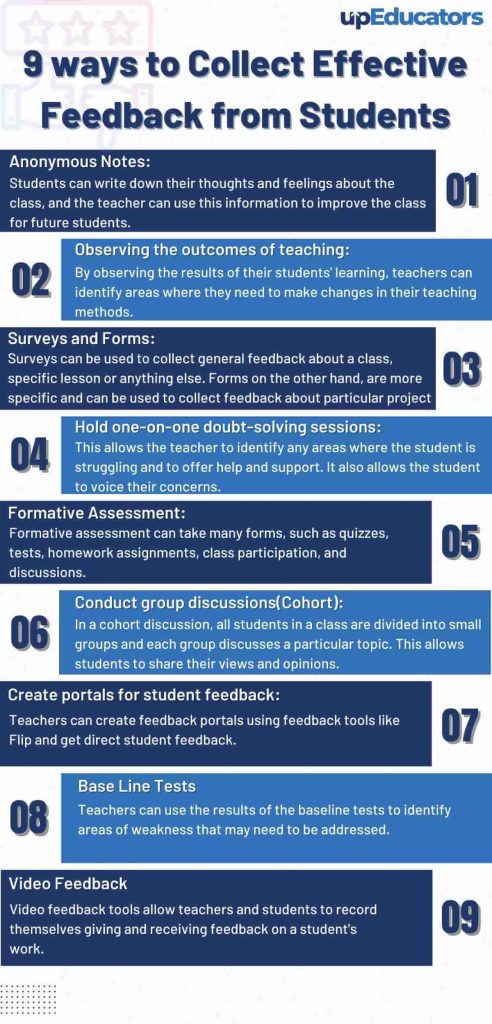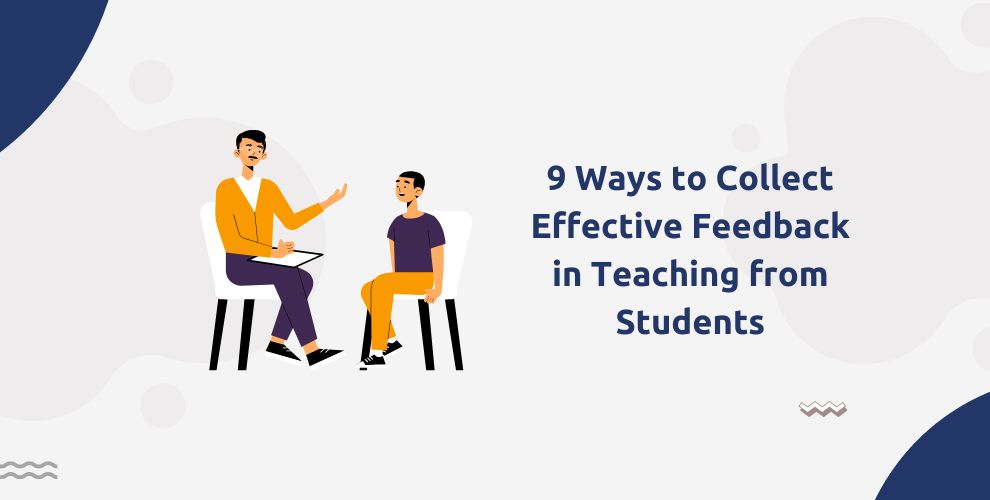A teacher took up a new batch of students for her online coaching class. During the demo sessions, she was confident in her teaching and was affirmative to getting a good response from the students. But after the demo classes, the feedback forms startled her. Most students found her lectures too fast-paced. But due to the feedback forms, she was able to locate the issue in her teaching method and address it for future batches.
Feedback is an indispensable part of the teaching-learning process. And the process of feedback goes both ways. Teachers need to give timely and effective feedback to students to measure their performance in the classroom, tests and assignments.
But the process of feedback in teaching does not end here. Teachers also need some effective tools and strategies to collect feedback from their students. Every teacher needs to provide a framework where students can discuss openly the teaching methods used by a teacher in the classroom. This enables the teachers and students to understand where each of the parties stands in the classroom and opens up gates of improvement.

upEducators has trained 5000+ teachers in learning digital skills and pedagogies. After interacting with hundreds of teachers, our team has curated a list of effective strategies used by teachers to collect feedback in the classroom. Here are some of the most popular and widely-used strategies for feedback in the classroom by teachers.
Anonymous notes
There are many benefits to collecting feedback from students using anonymous notes. First, it allows students to feel more comfortable sharing their thoughts and feelings, knowing that their identity will not be revealed. This can lead to more honest feedback. Additionally, it can help to prevent any potential bias that the teacher may have towards certain students.
This is a great way to get honest feedback from students about their experiences in the classroom. Students can write down their thoughts and feelings about the class, and the teacher can use this information to improve the class for future students.
But remember that students can misuse the anonymous feedback options. Try it in your class first and then continue only if it works for you.
Observing the outcomes of teaching
Teachers can collect feedback from students by observing the outcomes of their teachings. This feedback can be used to improve the quality of the teacher’s instruction. By observing the results of their students’ learning, teachers can identify areas where they need to make changes in their teaching methods. This feedback can also be used to assess the effectiveness of the instructional materials being used.
Surveys and forms
Teachers can collect feedback from students in a variety of ways, but two of the most common methods are through surveys and forms. Surveys can be used to collect general feedback about a class, a specific lesson, or anything else. Forms, on the other hand, are more specific and can be used to collect feedback about a particular assignment or project.
Both surveys and forms have their advantages and disadvantages. Surveys are generally quicker and easier to administer, but they can be less specific and may not provide as much detail as forms. Forms, on the other hand, can be more time-consuming to administer, but they can provide more specific and detailed feedback.
Hold one-on-one doubt-solving sessions
Teachers can collect feedback from students by holding one on one doubt solving sessions. This allows the teacher to identify any areas where the student is struggling and to offer help and support. It also allows the student to voice any concerns they may have about the course material or the teaching methods. This feedback can be extremely valuable in helping teachers to improve their teaching and make sure that all students can succeed.
Formative Assessment
Teachers can collect feedback from students by holding one on one doubt solving sessions. This allows the teacher to identify any areas where the student is struggling and to offer help and support. It also allows the student to voice any concerns they may have about the course material or the teaching methods. This feedback can be extremely valuable in helping teachers to improve their teaching and make sure that all students can succeed.
Conduct Group Discussions for Feedback: (cohort)
Cohort discussions and group discussions are both excellent ways for teachers to collect feedback from students. In a cohort discussion, all students in a class are divided into small groups and each group discusses a particular topic. This allows students to share their views and opinions, and the teacher can get a sense of what the students are thinking. Group discussions are similar, but they can be conducted with any number of students, not just those in a class. This is a great way for teachers to get feedback on a particular lesson or assignment.
Create portals for Student Feedback: Mandatory
Teachers can create feedback portals using feedback tools like Flip and get direct student feedback. By doing this, teachers can collect feedback from a larger number of students more easily and efficiently. Additionally, it allows students to provide feedback anonymously, which can help ensure that students feel comfortable sharing their honest opinions. Furthermore, the feedback can be stored and accessed easily by teachers using a single feedback portal. But sometimes some students can take it lightly and may not participate in joining such portals. In such cases, teachers must make it mandatory for every student to join these portals and actively participate in giving feedback.
Base Line Test
Baseline tests are a great way for teachers to collect feedback from their students. By administering these tests at the beginning of the year, teachers can get a sense of where each student is starting academically. This information can be used to help tailor the instruction to better meet the needs of each student. Additionally, teachers can use the results of the baseline tests to identify areas of weakness that may need to be addressed. Overall, baseline tests are a valuable tool that can help teachers ensure that all of their students are making progress and meeting their academic goals.
Video Feedback
There are many video feedback tools that teachers can use to collect feedback from students. These tools allow teachers and students to record themselves giving and receiving feedback on a student’s work or a lesson, and then the student can watch the video and provide their feedback. This can be a great way to get students to engage with the feedback process and to ensure that they understand the feedback that they are receiving.
Feedback is that one thing that can drastically improve the outcomes of learning in the classroom. With the right feedback collection and distribution, the teaching-learning process becomes smooth in the classroom. Effective feedback in the classroom enhances learning, builds trust and even motivates students and teachers to be the best versions of themselves.
Author: This article is written by Samiya Rashid for upEducators blog.




